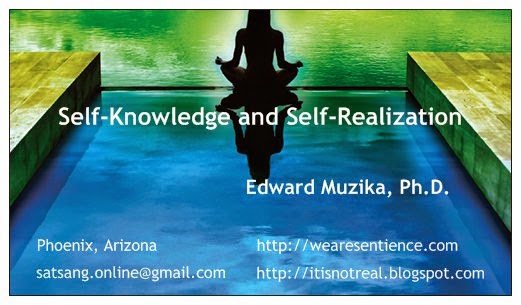PONDER THIS:
Robert used to say, “Ponder this!” and then recite some common argument or
theorem of Advaita Vedanta. Ramana did
the same, speaking to students about the nature of consciousness, and
Nisargadatta did also.
This is because Advaita Vedanta is not purely about self inquiry. Although self inquiry is the most prominent
method extolled by Ramana, Robert and Nisargadatta, in fact Advaita Vedanta has
a philosophy of existence, or ontology, as well as a philosophy of knowing and
the limits of knowing.
Pure self inquiry, without a foundation in a philosophical
model may prove to be both endless and fruitless. So the self inquiry proposed by all three
teachers above, is really a guided self inquiry within the confines of a
model. In fact, all spiritual teachings
and methods are like this, whether it is Kundalini Yoga, chucker yoga,
Christian mysticism, or the philosophy of the Bhagavad-Gita.
Thus there is a wide gap between pure self inquiry without
having any idea in mind, and self inquiry based on a model. The origins of Nisargadatta’s model lay in
the teachings of his guru, Siddharameshwar.
Siddharameshwar offered a model of the self of many layers, from the
body of waking consciousness with an external world perceived by a body, the more
subtle layer of internal energies found within one sense of presence, as well
as the bliss found that there, deeper to the causal body where mind was absent
and therefore perception was absent, to the lowest level, the deepest level,
Turiya, with a sense of I resides.
Beyond that was the absolute, which was the absolute I that new the eye
of existence.
However, unless one already believes the model, it is
unlikely herself in query without a model in mind would reach the same
understanding as self inquiry within the confines of a model of existence. Nor would the attempts at logical argumentation
by Robert, Nisargadatta or Ramana really make any sense.
For example, I present briefly a logical argument made by
Nisargadatta in one of his books. I will
not tell you where I found it, because that will force you to actually read his
books and look for the phrase if I do not tell you. I make you do some homework. Follow closely the brief argument he makes,
and ponder whether his conclusion follows from his premises, and whether those
premises can actually stand alone as obviously true.
“This is a subtle point, so try to understand it
clearly. When I say “I was not” prior to
conception, then what I actually mean is that I was not like this present “I
am.” But that “I” which could discern
this must be there to judge the absence of the present “I am.”
“Owing to the absence of a body, that “I” prior to conception
had no sense of being or sense of “I am-ness.”
With the arrival of a body the sense of “I am this” is imposed on the
prior “I.””
Now ponder this: as clearly as you can, restate Nisargadatta’s
argument in your own words. Does his
argument prove to you, make any sense to you, convince you, that there is a
pre-existing “I” to which a body appears, which then is able to witness a sense
of I am-ness?
There are many other arguments like this. Ramana says your body is not real, because it
does not exist when you sleep. But he
says consciousness, awareness, of sleep is there, because when you awaken in
the morning, you can say either I slept well, or I did not sleep well. That is, he is saying that there is a subtle
awareness that exists throughout sleep such that the morning after the mind
awakens, it remembers that it was aware of the sleep state.
I just want you to be aware that all teachers, or most all teachers,
have a model of existence or ontology, and of knowing or knowledge, called
epistemology, and they have a set of methods to confirm the model they are
passing on to their students.
Nisargadatta is a prime example of this. His teacher, Siddharameshwar, told him from
their first meeting, that he was not his body, that he must not identify with
his body, that he was Brahman, and even beyond that, the knower of
Brahman. He was given a mantra to be
repeated endlessly. The mantra was “I am
Brahman and Brahman is I.” In addition,
after realization, he developed the technique of fixating on the I am sensation
and following it to its root in Turiya and beyond, to the absolute or
para-Brahman.
Since almost all spiritual traditions rely on a model of
existence, and a model of knowing her knowledge, which shape our student’s
spiritual experiences, and which also provide a framework for his future
teachings to his own students. Because
there are so many different spiritual traditions, there are so many different
models of reality, such that there is a vast range of differing experiences and
methods, such that the awakening of one tradition conceivably is completely
different from the awakening or enlightenment aimed at in a different
tradition.
So ponder these things in your own way and your own time
when listening to various spiritual teachers are reading their books. Tried to tease out the underlying model that
that teacher has in mind when he or she speaks.
If you do this, you are well on your way to finding your own truth
because you question the source of the spiritual teachings you hear with your
ears or see with your eyes.


